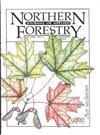Light-Use Efficiency and Photosynthetic Capacity of Northern White-Cedar (Thuja occidentalis L.) Cuttings Originated from Layering and Seed
引用次数: 4
Abstract
Northern white-cedar (Thuja occidentalis L.) regeneration originating from layering is generally considered to be more shade tolerant than that of seed origin. In this study, we examined photosynthetic light-use efficiency, an important component of shade tolerance, of these two forms of regeneration using light-response curves of 1-year-old rooted cuttings of layers and seedlings grown under low (20% of full sun) and high (90% of full sun) light conditions. Northern white-cedar showed a strong potential for photosynthetic acclimation to light availability, as indicated by significant differences in the light compensation point (LCP), dark respiration (R d ), apparent quantum efficiency (PE), and light saturation point (Q sat ) but not light-saturated rate of net photosynthesis (A max ) between cuttings grown under high and low light. Values of Rd, LCP, and PE did not differ between layers and seedlings grown under high and low light, but layers had higher Amax and Qsat than seedlings when grown under high light. This result may reflect a comparatively lower capacity for photosynthetic acclimation of seedlings to high light conditions, perhaps because of their younger physiological age. A lower capacity for photosynthetic acclimation to light in seedlings could limit the repair and recovery of their photosynthetic systems from damage associated with the more extreme microenvironments of open, recently disturbed sites.北方白杉的光能利用效率和光合能力插枝源于层和种子
一般认为,源自分层的北方白雪松(Thuja occidentalis L.)再生比源自种子的再生更耐阴。在本研究中,我们利用在低光照(20%)和高光照(90%)条件下生长的1年生层根扦插和幼苗的光响应曲线,研究了这两种再生形式的光合光能利用效率,这是耐阴性的一个重要组成部分。光补偿点(LCP)、暗呼吸(R d)、表观量子效率(PE)和光饱和点(Q sat)差异显著,但净光合作用光饱和速率(a max)差异不显著。各层间和高、弱光下幼苗间的Rd、LCP和PE值无显著差异,但各层间的Amax和Qsat值高于强光下幼苗。这一结果可能反映了幼苗对强光条件的光合适应能力相对较低,可能是因为它们的生理年龄较年轻。幼苗光合适应光的能力较低,可能会限制其光合系统从开放的、最近受到干扰的更极端微环境中受损的修复和恢复。
本文章由计算机程序翻译,如有差异,请以英文原文为准。
求助全文
约1分钟内获得全文
求助全文

 求助内容:
求助内容: 应助结果提醒方式:
应助结果提醒方式:


